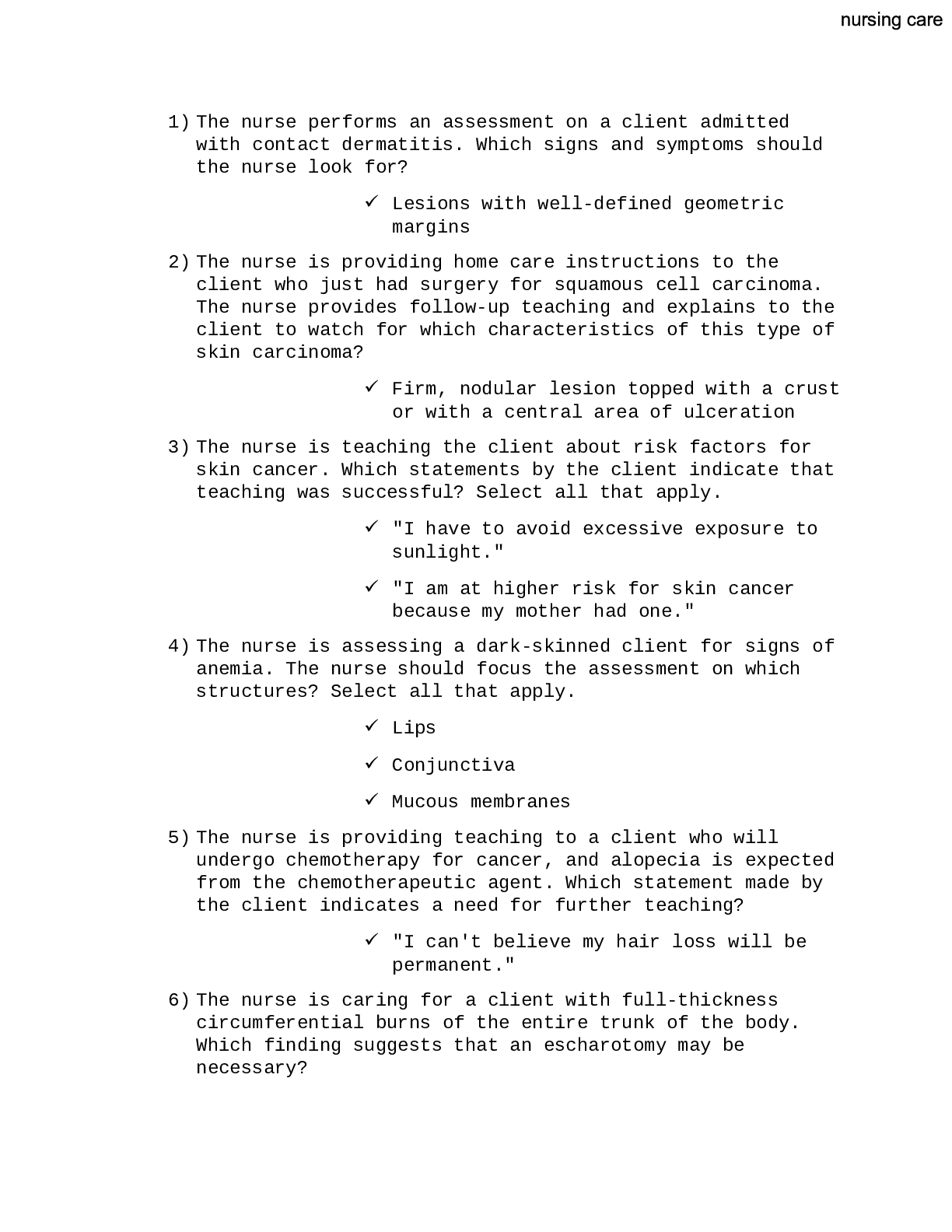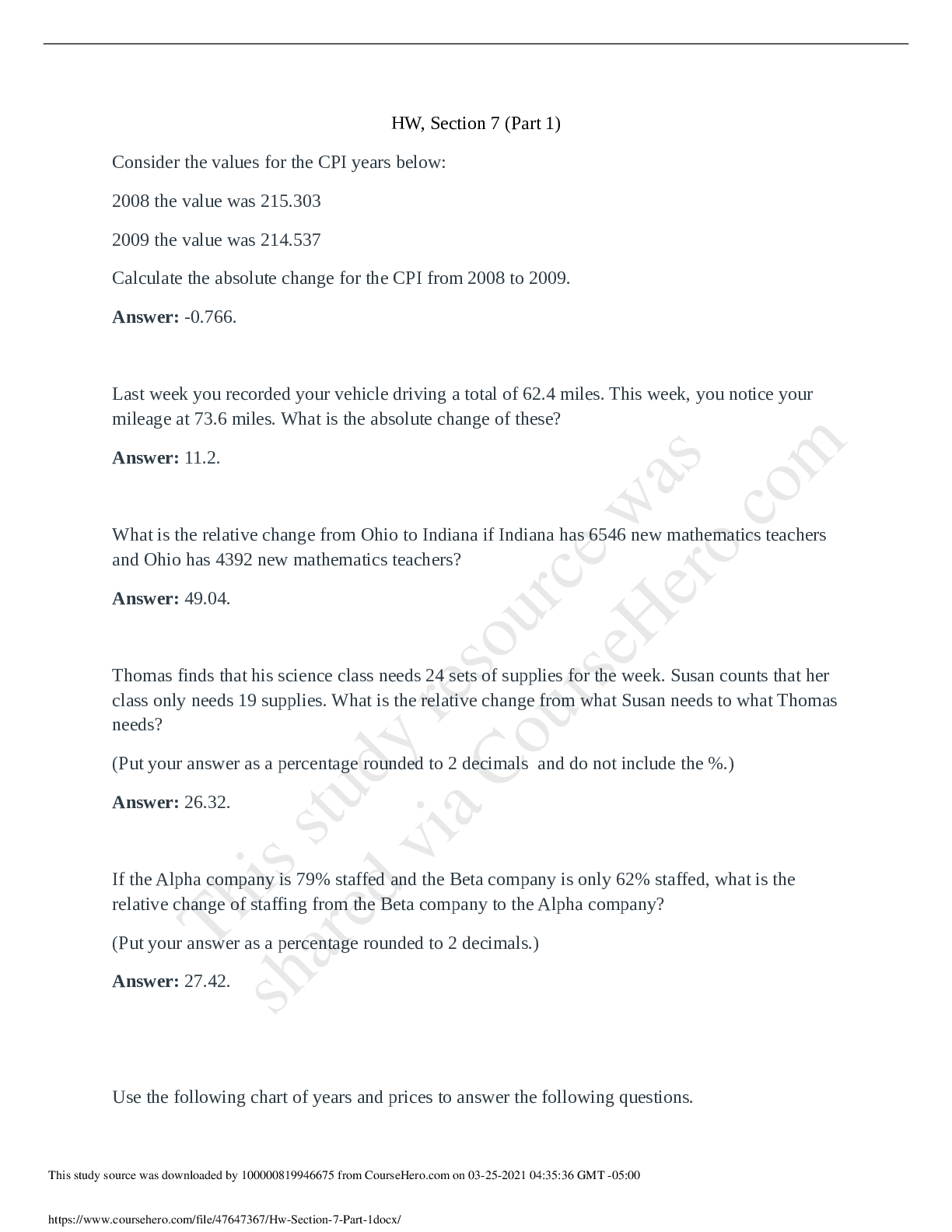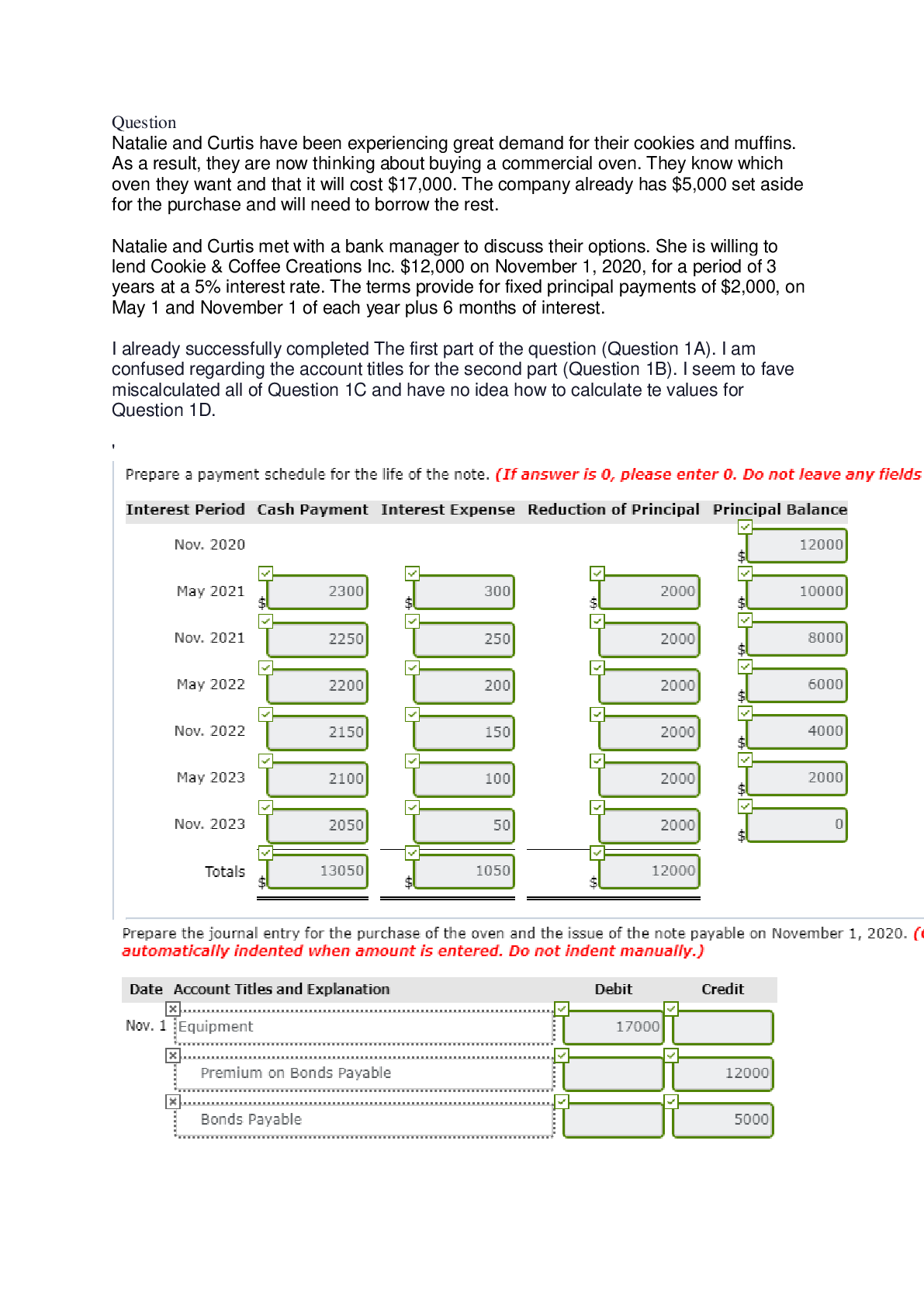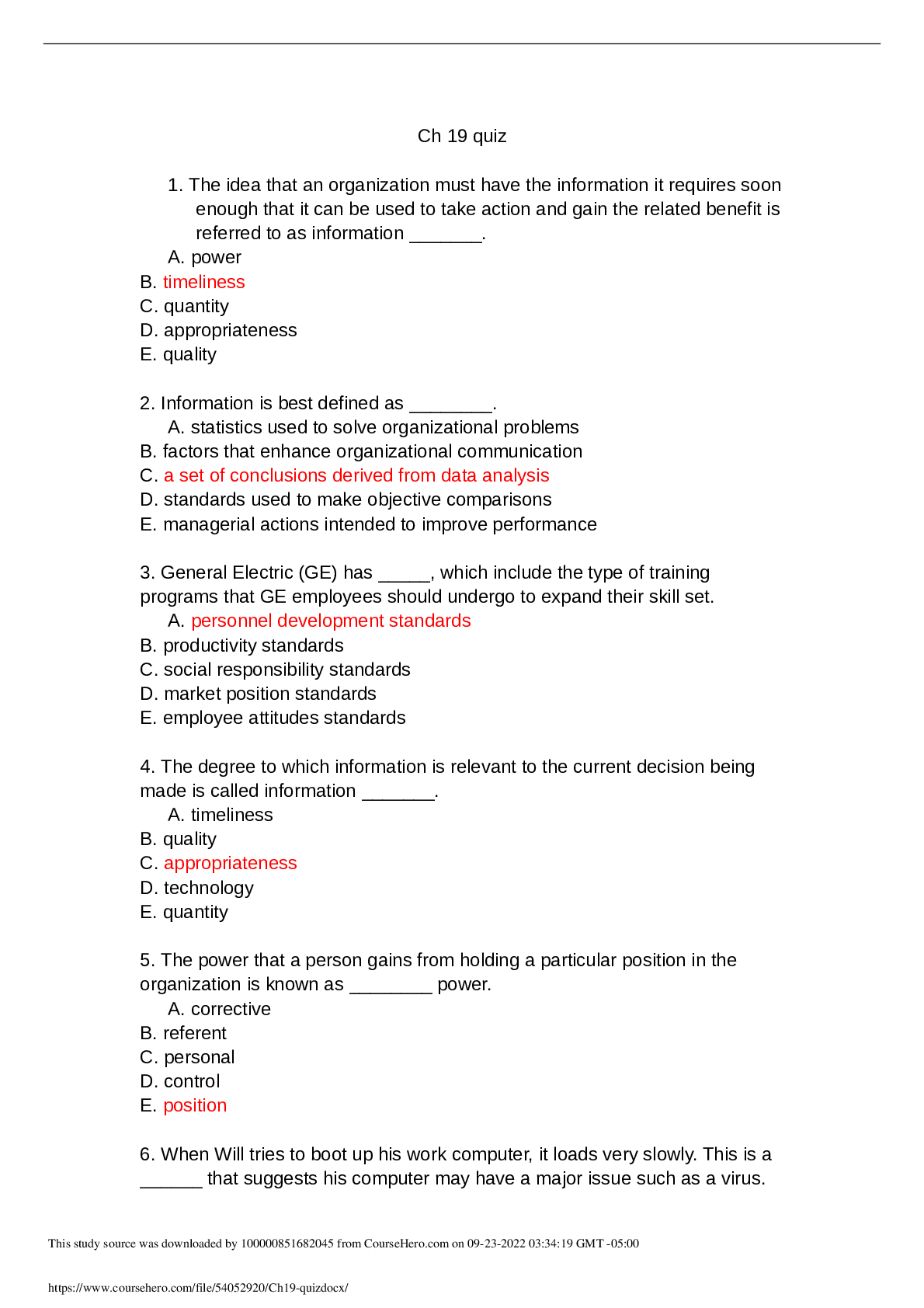*NURSING > QUESTIONS & ANSWERS > Ivy Tech Community College of Indiana - NURSING, nrsg 100 (ALREADY GRADED A) (All)
Ivy Tech Community College of Indiana - NURSING, nrsg 100 (ALREADY GRADED A)
Document Content and Description Below
A client has received a transfusion of platelets. The nurse evaluates that the client is benefiting most from this therapy if the client exhibits which finding? The nurse has obtained a unit of blood... from the blood bank and has checked the blood bag properly with another nurse. Just before beginning the transfusion, the nurse should assess which priority item? The nurse has just received a prescription to transfuse a unit of packed red blood cells for an assigned client. What action should the nurse take next? Following infusion of a unit of packed red blood cells, the client has developed new onset of tachycardia, bounding pulses, crackles, and wheezes. Which action should the nurse implement first? The nurse, listening to the morning report, learns that an assigned client received a unit of granulocytes the previous evening. The nurse makes a note to assess the results of which daily serum laboratory studies to assess the effectiveness of the transfusion? A client is brought to the emergency department having experienced blood loss related to an arterial laceration. Which blood component should the nurse expect the health care provider to prescribe? The nurse who is about to begin a blood transfusion knows that blood cells start to deteriorate after a certain period of time. The nurse takes which actions in order to prevent a complication of the blood transfusion as it relates to deterioration of blood cells? Select all that apply. A client requiring surgery is anxious about the possible need for a blood transfusion during or after the procedure. The nurse suggests to the client to take which actions to reduce the risk of possible transfusion complications? Select all that apply. A client with severe blood loss resulting from multiple trauma requires rapid transfusion of several units of blood. The nurse asks another health team member to obtain which device for use during the transfusion procedure to help reduce the risk of cardiac dysrhythmias? A client has a prescription to receive a unit of packed red blood cells. The nurse should obtain which intravenous (IV) solution from the IV storage area to hang with the blood product at the client's bedside? The nurse is caring for a client who is receiving a blood transfusion and is complaining of a cough. The nurse checks the client's vital signs, which include temperature of 97.2°F (36.2°C), pulse of 108 beats per minute, blood pressure of 152/76 mm Hg, respiratory rate of 24 breaths per minute, and an oxygen saturation level of 95% on room air. The client denies pain at this time. Based on this information, what initial action should the nurse take? A Spanish-speaking client arrives at the triage desk in the emergency department and states to the nurse, "No speak English, need interpreter." Which is the best action for the nurse to take? Page an interpreter from the hospital's interpreter services. The nurse is performing a neurological assessment on a client and elicits a positive Romberg's sign. The nurse makes this determination based on which observation? A significant sway when the client stands erect with feet together, arms at the side, and the eyes closed The nurse notes documentation that a client is exhibiting Cheyne-Stokes respirations. On assessment of the client, the nurse should expect to note which finding? Rhythmic respirations with periods of apnea A client diagnosed with conductive hearing loss asks the nurse to explain the cause of the hearing problem. The nurse plans to explain to the client that this condition is caused by which problem? A physical obstruction to the transmission of sound waves While performing a cardiac assessment on a client with an incompetent heart valve, the nurse auscultates a murmur. The nurse documents the finding and describes the sound as which? A blowing or swooshing noise The nurse is testing the extraocular movements in a client to assess for muscle weakness in the eyes. The nurse should implement which assessment technique to assess for muscle weakness in the eye? Test the 6 cardinal positions of gaze. The nurse is instructing a client how to perform a testicular self-examination (TSE). The nurse should explain that which is the best time to perform this exam? After a shower or bath The nurse is assessing a client for meningeal irritation and elicits a positive Brudzinski's sign. Which finding did the nurse observe? The client passively flexes the hip and knee in response to neck flexion and reports pain in the vertebral column. A client with a diagnosis of asthma is admitted to the hospital with respiratory distress. Which type of adventitious lung sounds should the nurse expect to hear when performing a respiratory assessment on this client? Wheezes The clinic nurse prepares to perform a focused assessment on a client who is complaining of symptoms of a cold, a cough, and lung congestion. Which should the nurse include for this type of assessment? Select all that apply. Auscultating lung sounds Obtaining the client's temperature Obtaining information about the client's respirations The nurse is preparing to initiate an intravenous (IV) line containing a high dose of potassium chloride and plans to use an IV infusion pump. The nurse brings the pump to the bedside, prepares to plug the pump cord into the wall, and notes that no receptacle is available in the wall socket. The nurse should take which action? Contact the electrical maintenance department for assistance. The nurse obtains a prescription from a health care provider to restrain a client and instructs an unlicensed assistive personnel (UAP) to apply the safety device to the client. Which observation of unsafe application of the safety device would indicate that further instruction is required by the UAP? Safely securing the safety device straps to the side rails The community health nurse is providing a teaching session about anthrax to members of the community and asks the participants about the methods of transmission. Which answers by the participants would indicate that teaching was effective? Select all that apply. Inhalation of bacterial spores Through a cut or abrasion in the skin Ingestion of contaminated undercooked meat The nurse is giving a report to an unlicensed assistive personnel (UAP) who will be caring for a client who has hand restraints (safety devices). The nurse instructs the UAP to check the skin integrity of the restrained hands how frequently? Every 30 minutes The nurse is reviewing a plan of care for a client with an internal radiation implant. Which intervention, if noted in the plan, indicates the need for revision of the plan? Placing the client in a semiprivate room at the end of the hallway Contact precautions are initiated for a client with a health care–associated (nosocomial) infection caused by methicillin-resistant Staphylococcus aureus. The nurse prepares to provide colostomy care and should obtain which protective items to perform this procedure? Gloves, gown, goggles, and a mask or face shield The nurse enters a client's room and finds that the wastebasket is on fire. The nurse immediately assists the client out of the room. What is the next nursing action? Activate the fire alarm. A mother calls a neighbor who is a nurse and tells the nurse that her 3-year-old child has just ingested liquid furniture polish. The nurse would direct the mother to take which immediate action? Call the Poison Control Center. The emergency department (ED) nurse receives a telephone call and is informed that a tornado has hit a local residential area and that numerous casualties have occurred. The victims will be brought to the ED. The nurse should take which initial action? Activate the emergency response plan. The nurse is caring for a client with meningitis and implements which transmission-based precautions for this client? Private room or cohort client The nurse working in the emergency department (ED) is assessing a client who recently returned from Liberia and presented complaining of a fever at home, fatigue, muscle pain, and abdominal pain. Which action should the nurse take next? Isolate the client in a private room. A health care provider's prescription reads 1000 mL of normal saline (NS) to infuse over 12 hours. The drop factor is 15 drops (gtt)/1 mL. The nurse prepares to set the flow rate at how many drops per minute? Fill in the blank. Record your answer to the nearest whole number. 21 drops per minute A health care provider's prescription reads to administer an intravenous (IV) dose of 400,000 units of penicillin G benzathine. The label on the 10-mL ampule sent from the pharmacy reads penicillin G benzathine, 300,000 units/mL. The nurse prepares how much medication to administer the correct dose? Fill in the blank. Record your answer using 1 decimal place. 1.3 mL A health care provider's prescription reads potassium chloride 30 mEq to be added to 1000 mL normal saline (NS) and to be administered over a 10-hour period. The label on the medication bottle reads 40 mEq/20 mL. The nurse prepares how many milliliters of potassium chloride to administer the correct dose of medication? Fill in the blank. 15 mL A health care provider's prescription reads clindamycin phosphate 0.3 g in 50 mL normal saline (NS) to be administered intravenously over 30 minutes. The medication label reads clindamycin phosphate 900 mg in 6 mL. The nurse prepares how many milliliters of the medication to administer the correct dose? Fill in the blank. 2 mL A health care provider's prescription reads phenytoin 0.2 g orally twice daily. The medication label states that each capsule is 100 mg. The nurse prepares how many capsule(s) to administer 1 dose? Fill in the blank. 2 capsule(s) A health care provider prescribes 1000 mL of normal saline 0.9% to infuse over 8 hours. The drop factor is 15 drops (gtt)/1 mL. The nurse sets the flow rate at how many drops per minute? Fill in the blank. Record your answer to the nearest whole number. 31 drops per minute A health care provider prescribes heparin sodium, 1300 units/hour by continuous intravenous (IV) infusion. The pharmacy prepares the medication and delivers an IV bag labeled heparin sodium 20,000 units/250 mL D5W. An infusion pump must be used to administer the medication. The nurse sets the infusion pump at how many milliliters per hour to deliver 1300 units/hour? Fill in the blank. Record your answer to the nearest whole number. 16 mL per hour A health care provider prescribes 3000 mL of D5W to be administered over a 24-hour period. The nurse determines that how many milliliters per hour will be administered to the client? Fill in the blank. 125 mL per hour Gentamicin sulfate, 80 mg in 100 mL normal saline (NS), is to be administered over 30 minutes. The drop factor is 10 drops (gtt)/1 mL. The nurse sets the flow rate at how many drops per minute? Fill in the blank. Record your answer to the nearest whole number. 33 drops per minute A health care provider's prescription reads levothyroxine, 150 mcg orally daily. The medication label reads levothyroxine, 0.1 mg/tablet. The nurse administers how many tablet(s) to the client? Fill in the blank. 1.5 tablet(s) Cefuroxime sodium, 1 g in 50 mL normal saline (NS), is to be administered over 30 minutes. The drop factor is 15 drops (gtt)/1 mL. The nurse sets the flow rate at how many drops per minute? Fill in the blank. 25 drops per minute A health care provider prescribes 1000 mL D5W to infuse at a rate of 125 mL/hour. The nurse determines that it will take how many hours for 1 L to infuse? Fill in the blank. 8 hour(s) A health care provider prescribes 1 unit of packed red blood cells to infuse over 4 hours. The unit of blood contains 250 mL. The drop factor is 10 drops (gtt)/1 mL. The nurse prepares to set the flow rate at how many drops per minute? Fill in the blank. Record your answer to the nearest whole number. 10 gtt/min A health care provider's prescription reads morphine sulfate, 8 mg stat. The medication ampule reads morphine sulfate, 10 mg/mL. The nurse prepares how many milliliters to administer the correct dose? Fill in the blank. 0.8 mL A health care provider prescribes regular insulin, 8 units/hour by continuous intravenous (IV) infusion. The pharmacy prepares the medication and then delivers an IV bag labeled 100 units of regular insulin in 100 mL normal saline (NS). An infusion pump must be used to administer the medication. The nurse sets the infusion pump at how many milliliters per hour to deliver 8 units/hour? Fill in the blank. 0.8 mL/hour The nurse has just reassessed the condition of a postoperative client who was admitted 1 hour ago to the surgical unit. The nurse plans to monitor which parameter most carefully during the next hour? Urinary output of 20 mL/hour The nurse is teaching a client about coughing and deep-breathing techniques to prevent postoperative complications. Which statement is most appropriate for the nurse to make to the client at this time as it relates to these techniques? "Use of an incentive spirometer will help prevent pneumonia." The nurse is creating a plan of care for a client scheduled for surgery. The nurse should include which activity in the nursing care plan for the client on the day of surgery? Have the client void immediately before going into surgery. A client with a gastric ulcer is scheduled for surgery. The client cannot sign the operative consent form because of sedation from opioid analgesics that have been administered. The nurse should take which most appropriate action in the care of this client? Obtain a telephone consent from a family member, following agency policy. A preoperative client expresses anxiety to the nurse about upcoming surgery. Which response by the nurse is most likely to stimulate further discussion between the client and the nurse "Can you share with me what you've been told about your surgery?" The nurse is conducting preoperative teaching with a client about the use of an incentive spirometer. The nurse should include which piece of information in discussions with the client? The best results are achieved when sitting up or with the head of the bed elevated 45 to 90 degrees. The nurse has conducted preoperative teaching for a client scheduled for surgery in 1 week. The client has a history of arthritis and has been taking acetylsalicylic acid. The nurse determines that the client needs additional teaching if the client makes which statement? "I need to continue to take the aspirin until the day of surgery." The nurse assesses a client's surgical incision for signs of infection. Which finding by the nurse would be interpreted as a normal finding at the surgical site? Serous drainage The nurse is monitoring the status of a postoperative client in the immediate postoperative period. The nurse would become most concerned with which sign that could indicate an evolving complication? Increasing restlessness A client who has had abdominal surgery complains of feeling as though "something gave way" in the incisional site. The nurse removes the dressing and notes the presence of a loop of bowel protruding through the incision. Which interventions should the nurse take? Select all that apply. Contact the surgeon. Instruct the client to remain quiet. Prepare the client for wound closure. Document the findings and actions taken. A client who has undergone preadmission testing has had blood drawn for serum laboratory studies, including a complete blood count, coagulation studies, and electrolytes and creatinine levels. Which laboratory result should be reported to the surgeon's office by the nurse, knowing that it could cause surgery to be postponed? Hemoglobin, 8.0 g/dL (80 mmol/L) The nurse receives a telephone call from the postanesthesia care unit stating that a client is being transferred to the surgical unit. The nurse plans to take which action first on arrival of the client? Assess the patency of the airway. The nurse is reviewing a surgeon's prescription sheet for a preoperative client that states that the client must be nothing by mouth (NPO) after midnight. The nurse should call the surgeon to clarify that which medication should be given to the client and not withheld? Prednisone A client is being prepared for a thoracentesis. The nurse should assist the client to which position for the procedure? Lying in bed on the unaffected side The nurse is caring for a client following a craniotomy, in which a large tumor was removed from the left side. In which position can the nurse safely place the client? Click on the image to indicate your answer. A The nurse creates a plan of care for a client with deep vein thrombosis. Which client position or activity in the plan should be included? Bed rest with elevation of the affected extremity The nurse is caring for a client who is 1 day postoperative for a total hip replacement. Which is the best position in which the nurse should place the client? On the nonoperative side with the legs abducted The nurse is providing instructions to a client and the family regarding home care after right eye cataract removal. Which statement by the client would indicate an understanding of the instructions? "I should sleep on my left side." The nurse is administering a cleansing enema to a client with a fecal impaction. Before administering the enema, the nurse should place the client in which position? Left Sims' position A client has just returned to a nursing unit after an above-knee amputation of the right leg. The nurse should place the client in which position? Supine, with the residual limb supported with pillows The nurse is caring for a client with a severe burn who is scheduled for an autograft to be placed on the lower extremity. The nurse creates a postoperative plan of care for the client and should include which intervention in the plan? Elevate and immobilize the grafted extremity. The nurse is preparing to care for a client who has returned to the nursing unit following cardiac catheterization performed through the femoral vessel. The nurse checks the health care provider's (HCP's) prescription and plans to allow which client position or activity following the procedure? Bed rest with head elevation no greater than 30 degrees The nurse is preparing to insert a nasogastric tube into a client. The nurse should place the client in which position for insertion? High Fowler's The nurse is preparing to administer medication using a client's nasogastric tube. Which actions should the nurse take before administering the medication? Select all that apply. Check the residual volume. Aspirate the stomach contents. Turn off the suction to the nasogastric tube. Test the stomach contents for a pH indicating acidity. The nurse is preparing to administer medication through a nasogastric tube that is connected to suction. To administer the medication, the nurse should take which action? Clamp the nasogastric tube for 30 to 60 minutes following administration of the medication. The nurse is assessing for correct placement of a nasogastric tube. The nurse aspirates the stomach contents, checks the gastric pH, and notes a pH of 7.35. Based on this information, which action should the nurse take at this time? Call the health care provider to request a prescription for a chest radiograph. The nurse caring for a client with a chest tube turns the client to the side and the chest tube accidentally disconnects from the water seal chamber. Which initial action should the nurse take? Place the tube in a bottle of sterile water. The registered nurse is preparing to insert a nasogastric tube in an adult client. To determine the accurate measurement of the length of the tube to be inserted, the nurse should take which action? Place the tube at the tip of the nose and measure by extending the tube to the earlobe and then down to the xiphoid process. The nurse is assessing the functioning of a chest tube drainage system in a client who has just returned from the recovery room following a thoracotomy with wedge resection. Which are the expected assessment findings? Select all that apply. Drainage system maintained below the client's chest 50 mL of drainage in the drainage collection chamber Occlusive dressing in place over the chest tube insertion site Fluctuation of water in the tube in the water seal chamber during inhalation and exhalation The nurse is assisting a health care provider with the removal of a chest tube. The nurse should instruct the client to take which action? Perform the Valsalva maneuver. While changing the tapes on a newly inserted tracheostomy tube, the client coughs and the tube is dislodged. Which is the initial nursing action? Grasp the retention sutures to spread the opening. The nurse is caring for a client immediately after removal of the endotracheal tube. The nurse should report which sign immediately if experienced by the client? Stridor The nurse checks for residual before administering a bolus tube feeding to a client with a nasogastric tube and obtains a residual amount of 150 mL. What is the most appropriate action for the nurse to take? Hold the feeding and reinstill the residual amount. [Show More]
Last updated: 2 years ago
Preview 1 out of 11 pages

Buy this document to get the full access instantly
Instant Download Access after purchase
Buy NowInstant download
We Accept:

Reviews( 0 )
$10.00
Can't find what you want? Try our AI powered Search
Document information
Connected school, study & course
About the document
Uploaded On
Apr 11, 2020
Number of pages
11
Written in
Additional information
This document has been written for:
Uploaded
Apr 11, 2020
Downloads
0
Views
95

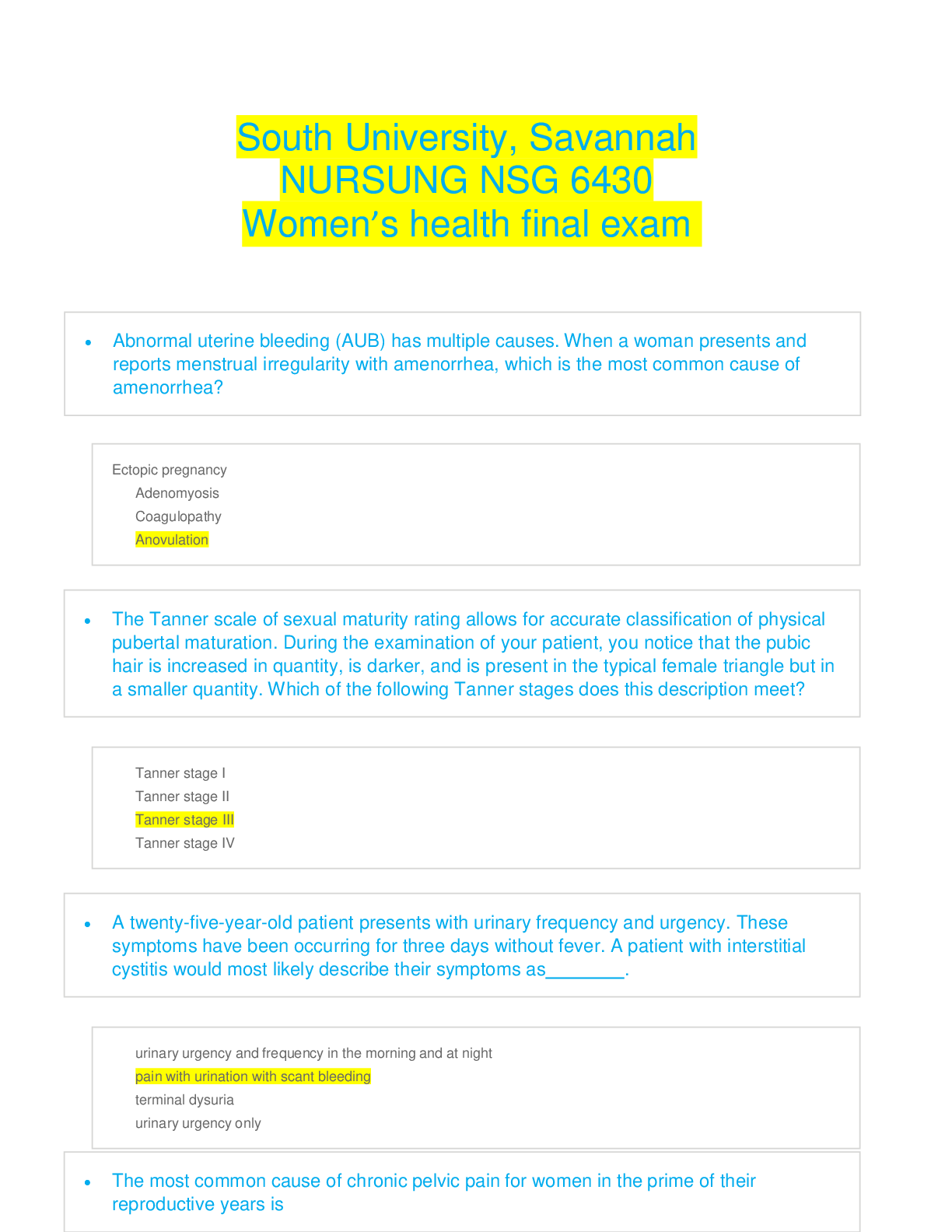

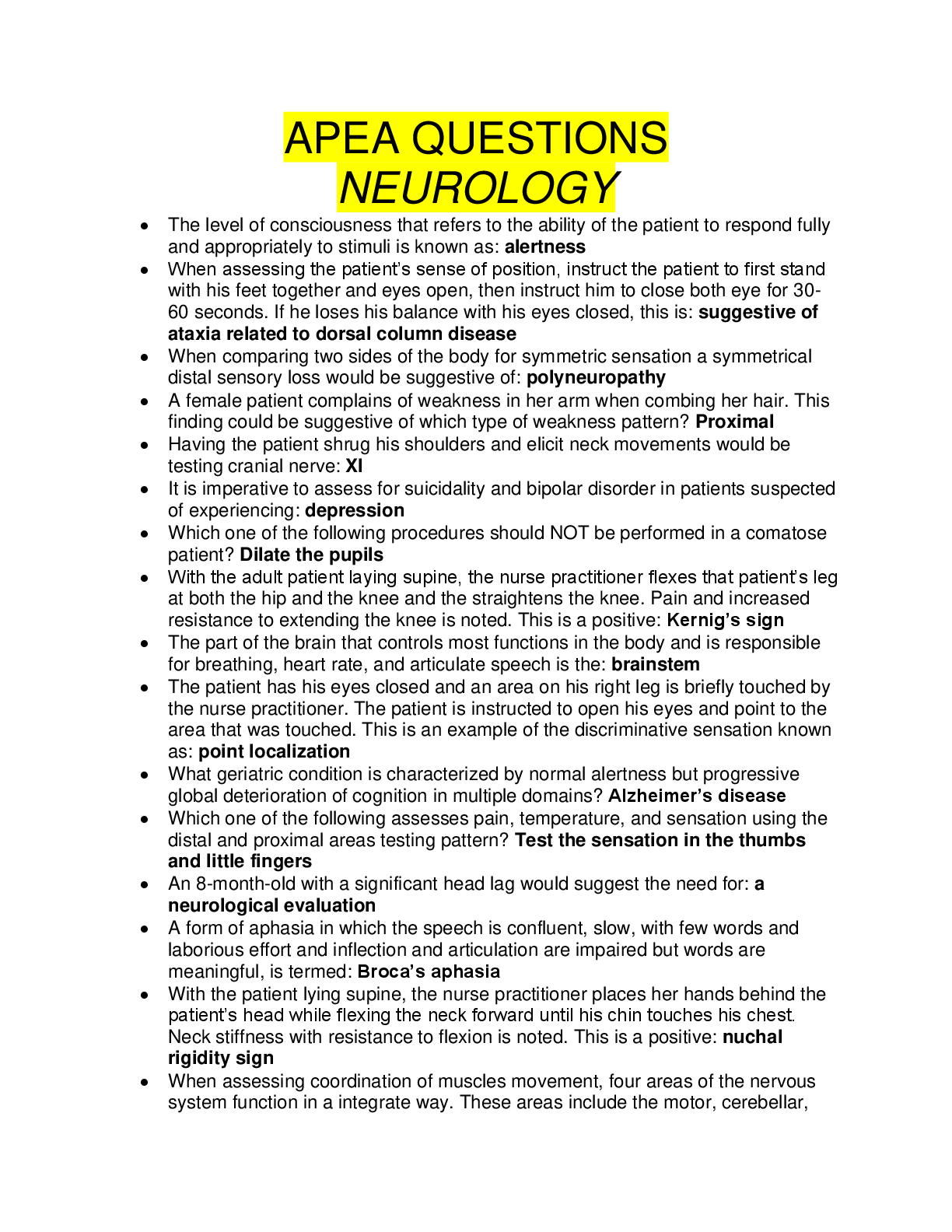

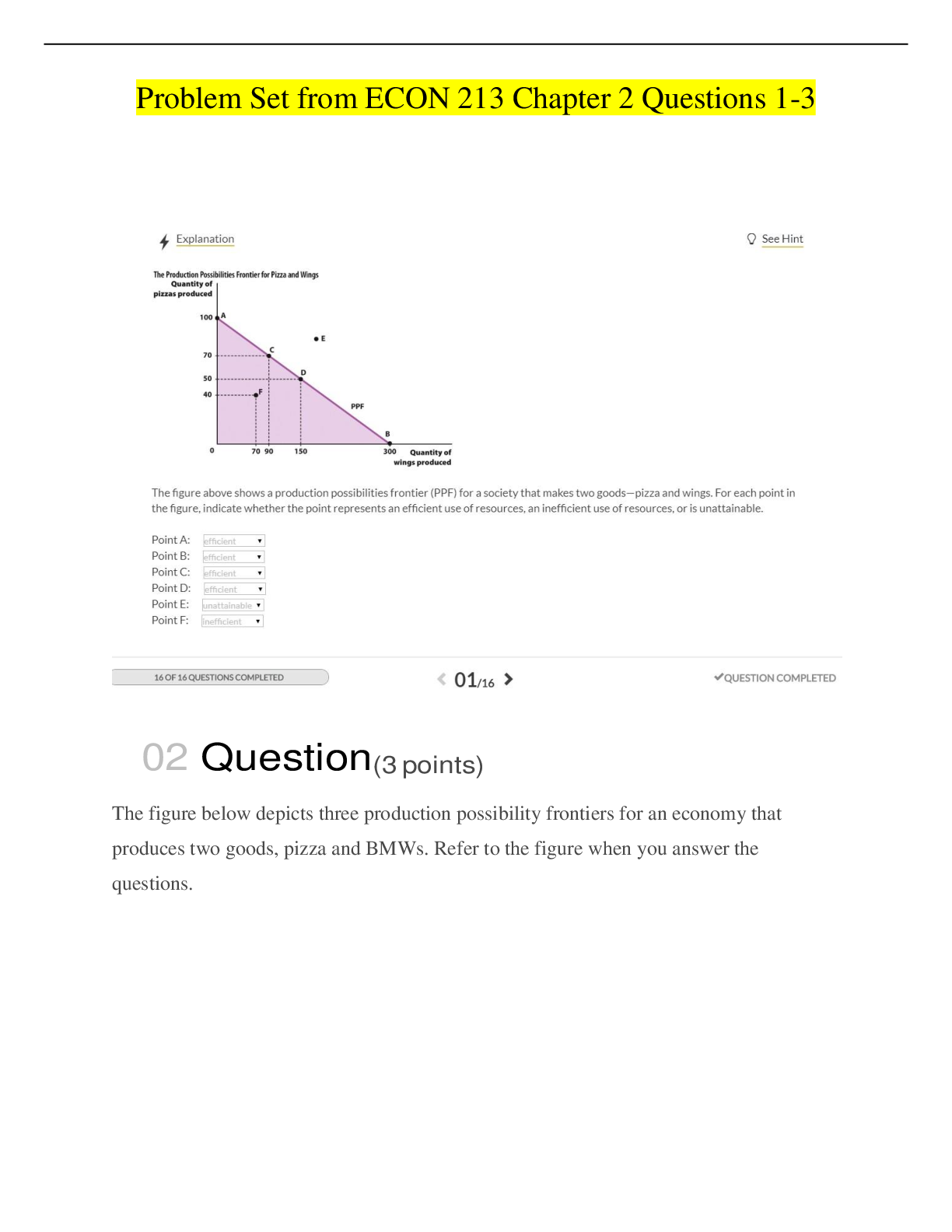
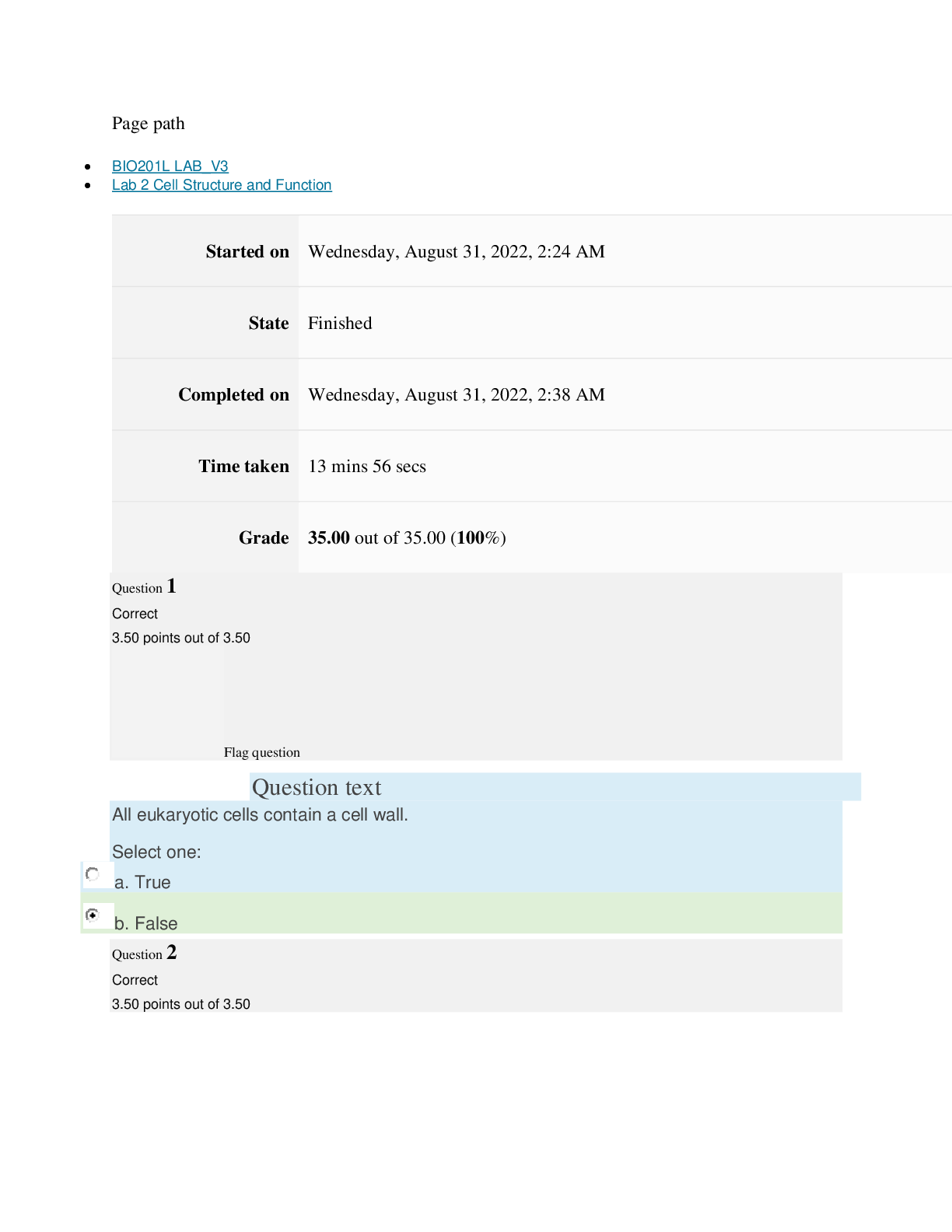

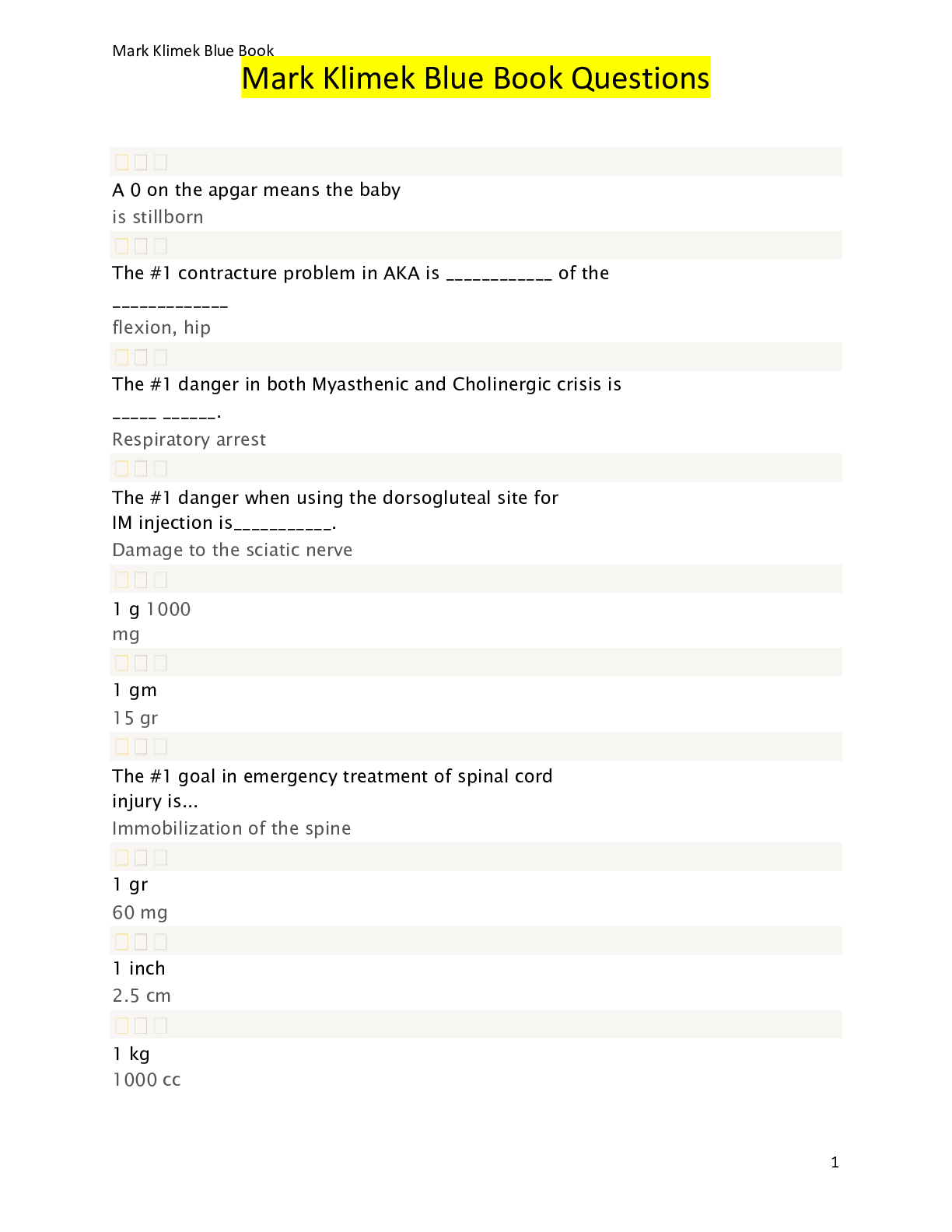

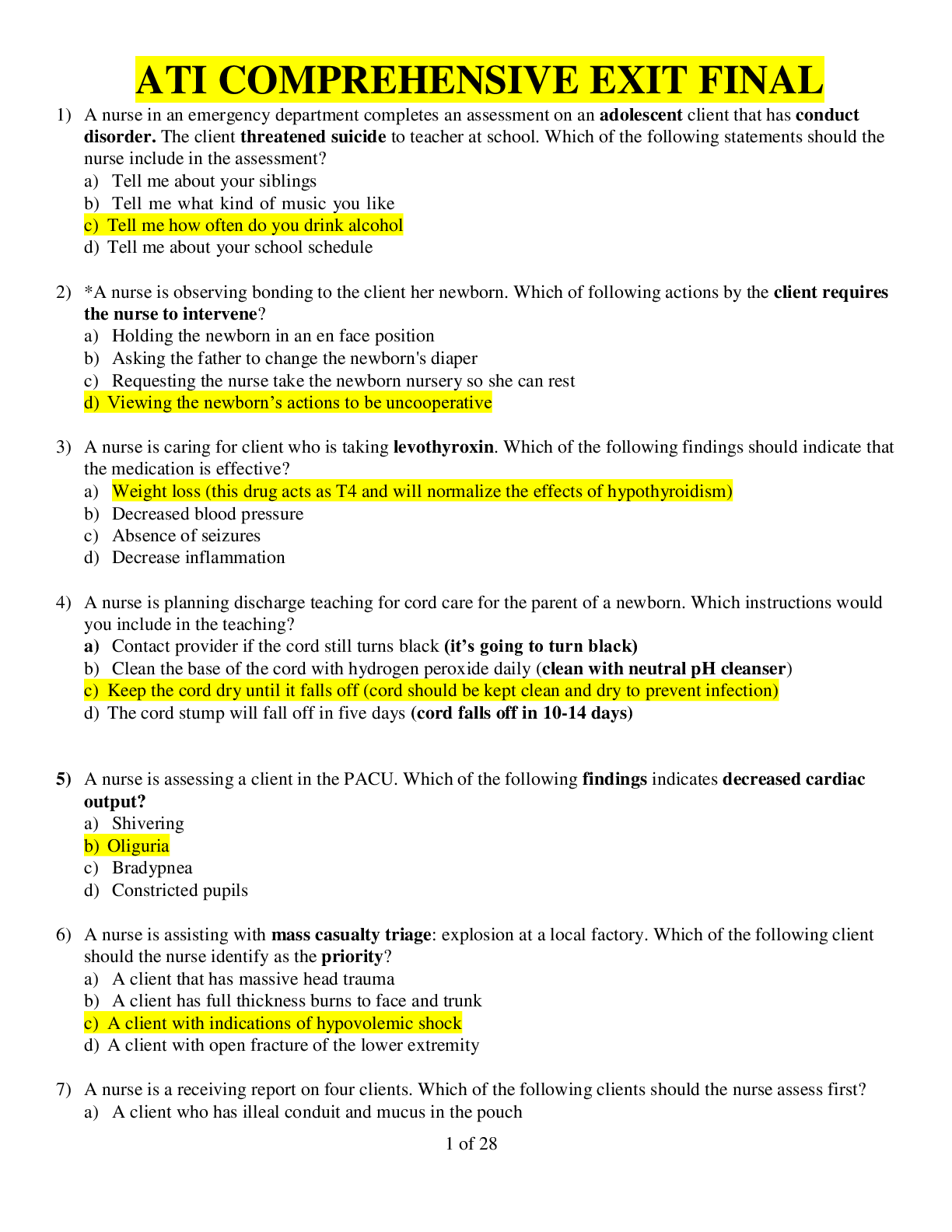


.png)


